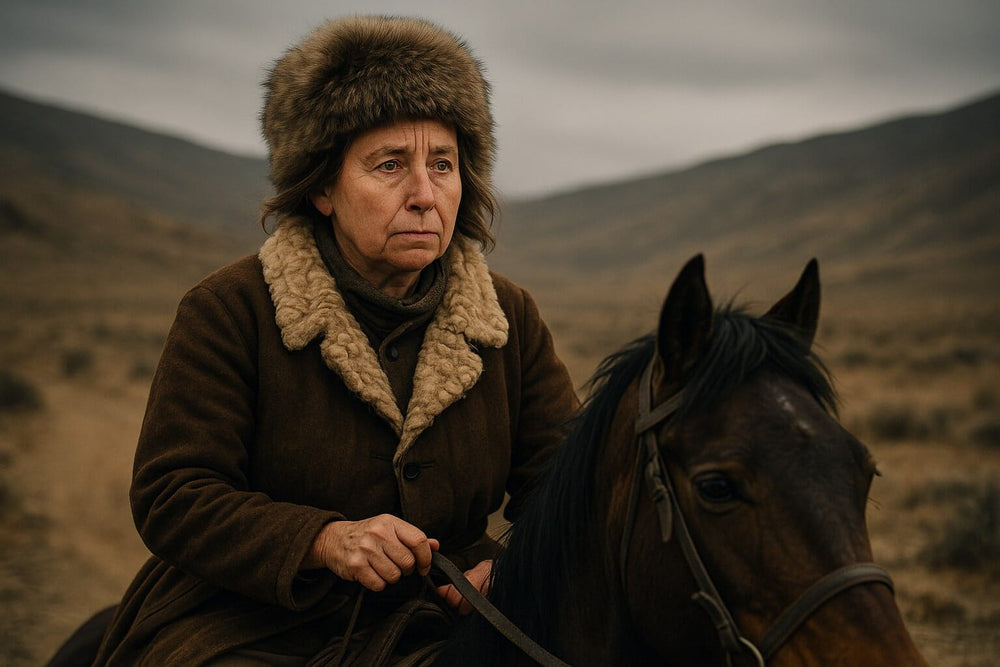
Alexandra David-Néel – The Woman Who Walked Beyond the Map
Reading Time: about 3 minutes
In 1969, in a quiet stone house in the hills of Provence, a 100-year-old woman sat surrounded by trunks. Inside: letters from lamas, prayer flags sun-bleached by Himalayan wind, worn notebooks inked in French and Tibetan. On the mantel, a photograph of a younger self — wrapped in robes, eyes steady, face burned by altitude and silence. Her name was Alexandra David-Néel. Explorer. Scholar. Buddhist. Anarchist. And one of the wildest minds the modern world has tried to forget.
She didn’t leave behind heirs or monuments. What she left was harder to pin down: a life built on disobedience, distance, and devotion to the unknown. She had crossed deserts and glaciers, disguised herself as a pilgrim to enter forbidden Lhasa, translated tantric texts by candlelight, and meditated in Himalayan caves at 4,000 meters. Not because it was fashionable — but because she couldn’t breathe in the world she was born into.
By the end, she no longer believed in countries, comfort, or certainty. She believed in the next question. And in the silence that follows it.
📚 Born with a Spine Full of Static
Alexandra David-Néel was born in 1868, in Paris, but her childhood didn’t follow the script of polite society. Her father was a free-thinking Huguenot who had walked away from religion. Her mother was a Belgian Catholic with strict views and tighter expectations. Alexandra grew up caught between ideologies — and learned early how to step outside both.
While other children learned embroidery, Alexandra devoured philosophy, Sanskrit, and anarchist tracts. By sixteen, she was publishing essays in radical journals. By twenty, she had run away from home — not once, but twice. The first time, she tried to reach England. The second, she made it to Switzerland on foot. She didn’t want marriage. She wanted motion.
She studied at the Sorbonne, took classes in Eastern religions, and haunted the Orientalist reading rooms of Paris like a pilgrim with no shrine. “I wanted to understand the sacred, but not from those who had turned it into marble,” she later wrote. For Alexandra, books weren’t trophies — they were launchpads.
By her twenties, she was already an intellectual anomaly: a woman fluent in Eastern languages, hostile to nationalism, and allergic to belonging. The stage was calling — but not the one you’d expect.
🎭 A Stage and a Steamer
At twenty-four, Alexandra David-Néel stepped onto the stage — not as a mystic, but as a professional opera singer. Her voice was sharp, her French perfect, and her contracts took her far: North Africa, Indochina, Tunisia. She played heroines in silk gowns under gaslight, while behind the curtain, her mind lingered on Sanskrit texts and Buddhist mantras.
Asia, for most Europeans in the 1890s, was a set piece: exotic, decorative, colonial. For Alexandra, it was already something else — a mirror, a magnet, a question. In the breaks between performances, she wandered markets, befriended locals, studied sacred texts. And slowly, the stage lost its glow. The real drama, she realized, was outside the theater.
She gave up her career mid-tour. Bought a one-way steamer ticket to Ceylon. Left behind costumes, applause, and polite expectations. “I was not made to please, but to seek,” she later said. What began as a tour became an immersion: India, Kashmir, Nepal, Sikkim. She walked, studied, meditated, listened. She wasn’t collecting souvenirs. She was burning through illusions.
The West called it wandering. She called it waking up.
🏔️ Into the Sacred: Disguised, Determined, and Forbidden
By the time Alexandra David-Néel reached the edges of Tibet, she had already lived in caves, learned from lamas, survived frostbite, and spent months in remote monasteries. But one place still burned in her mind like a distant fire: Lhasa, the forbidden city — closed to foreigners, surrounded by legend, and guarded by the twin forces of geography and empire.
In 1924, at 55 years old, she made her move. Disguised as a beggar-pilgrim with her adopted son and travel companion Yongden, she walked through the Himalayan snow in tattered clothes, her face darkened with soot, her French accent buried beneath fluent Tibetan. She crossed rivers on yak-hide rafts, bribed suspicious guards, and hid from patrols. For weeks, she walked by night and prayed by day. No backup. No camera crew. No permission.
When she finally stepped into Lhasa, it wasn’t triumph she felt — it was silence. She didn’t announce herself. She watched. She absorbed. She blended. She took notes only in her mind. For fifteen days, she lived anonymously in the heart of a city no Western woman had entered before her.
Alexandra didn’t come to plant a flag. She came to vanish — and in doing so, she saw more than any diplomat, missionary, or spy ever could. “I went not to conquer, but to surrender to something greater than myself,” she later wrote.
Her journey wasn’t a feat of athleticism. It was a spiritual infiltration — and a rebuke of every colonial narrative Europe had told itself about Asia. She wasn’t there to explain it. She was there to unlearn everything.
🌀 The Borderless Self: Ideas That Refused to Behave
Alexandra didn’t come back from Tibet with souvenirs. She came back with fractured truths and inconvenient insights — the kind that don’t sell postcards. She had seen Buddhist mysticism up close: the isolation, the rituals, the beauty, the contradictions. And she had returned with something rarer than footage — lucidity.
Her books — My Journey to Lhasa, Magic and Mystery in Tibet, Initiations and Initiates in Tibet — were not dreamy accounts of spiritual tourism. They were sharp, detailed, and often unromantic. She debunked superstition as often as she described it. She wrote not to convert, but to translate experience into thought — and thought into challenge.
She remained fiercely independent. She refused to join any school of thought. She was a Buddhist who doubted, a Western intellectual who distrusted Europe, a mystic who needed evidence. She once said: “To believe without questioning is not faith — it is surrender of the mind.” For Alexandra, belief was a tool — never a cage.
Long before “cultural appropriation” or “spiritual bypassing” entered common speech, she was walking the razor’s edge between reverence and critique. She wasn’t interested in copying Tibet. She was interested in what it demanded of her. And what it stripped away.
What remained was a woman no longer defined by nation, religion, or role. She had become something else: a borderless self, fluent in paradox, committed to uncertainty, and fluent in the art of asking better questions.
🪨 Return Is a Myth
After decades of wandering, Alexandra David-Néel returned to France — but not to “settle.” She found a house in Digne-les-Bains, Provence, surrounded by rocks and silence. She built a writing room. Planted nothing. Hosted no salons. From the outside, it looked like she had come home. But she hadn’t. Because there was no home to come back to.
She spent her last decades exactly as she had lived: writing, reading, and refusing to relax. She answered letters from curious readers, studied quantum theory, and annotated her own books. She maintained her Tibetan practice. She cooked little. Trusted few. She was, as one neighbor said, “not quite of this place.” Which was exactly right.
She outlived wars, empires, and her contemporaries — dying in 1969 at the age of 100. The world had changed, but Alexandra never chased it. She had already seen what lies beneath change: impermanence, ego, illusion, and longing. And she had accepted them all.
What she left behind was not a brand, or a movement. No Alexandra David-Néel Foundation. No documentary with voiceovers. Just books, letters, maps, and the echo of a life built on voluntary exile. The kind of exile that’s chosen — not to escape life, but to live it without armor.
🧭 What Alexandra David-Néel Still Teaches Us
In an age of curated identities, spiritual shortcuts, and adventure sold by algorithm, Alexandra David-Néel reminds us that the real journey is not always photogenic — and never simple. Her life is a challenge: to go beyond comfort, beyond imitation, beyond explanation.
She didn’t travel for spectacle. She traveled for erosion — of illusion, ego, and expectation. She walked into mountains and monasteries not to find answers, but to burn through the need for them. She didn’t want to belong. She wanted to understand. And when understanding failed, she stayed anyway.
She wasn’t a saint. She wasn’t a guide. She was a reminder that you don’t need to be easy to be true. That silence can speak. That solitude is not always a wound. That belief can sharpen you just as easily as it can soothe you.
Today, we map our lives with GPS, hashtags, and certainty. Alexandra left a different kind of map — one drawn in risk, refusal, altitude, and questions. If you follow it, be warned: there are no marked trails. Only weather. And will.
"The farther you go, the less you know. And that is the beginning of wisdom."
🗣 Words from the Edge – Alexandra David-Néel in Her Own Voice
-
“To believe without questioning is not faith — it is the death of the mind.”
— from Initiations and Initiates in Tibet (1931) -
“Travel does not exist without transformation — of the landscape, yes, but more importantly of the self.”
— personal letter to Albert de Pouvourville, 1929 -
“I craved solitude not to escape others, but to meet myself without distraction.”
— diary entry, Sikkim, 1912 -
“The farther one journeys into the unknown, the more one is asked to abandon the known within.”
— from Magic and Mystery in Tibet (1929) -
“It is not in Lhasa that I found Tibet — it was in silence, hardship, and the smile of a man who owned nothing.”
— unpublished manuscript notes, ca. 1925
🧭 Related Stories of Radical Explorers
- Isabelle Eberhardt – Ghost in the Colonial Machine
- Sylvain Tesson – Adventurer of Words and Wilderness
- Laura Dekker – The Youngest Solo Sailor Around the World
- Mike Horn – One of the Greatest Living Explorers
📌 Frequently Asked Questions
🕊️ How did Alexandra David-Néel die?
She died peacefully in 1969 at the age of 100 in her home in Digne-les-Bains, France. After decades of travel, writing, and study, she spent her final years in quiet solitude, still engaged in reading, annotating her own work, and practicing Tibetan Buddhism.
🌄 Why did Alexandra David-Néel go to Tibet?
She went to Tibet in search of spiritual truth and first-hand understanding of Tibetan Buddhism. Unlike tourists or colonial envoys, her goal wasn’t to observe, but to immerse herself in the culture, philosophy, and monastic life. Lhasa, the forbidden city, symbolized a place beyond external and internal borders — and she risked everything to reach it.
📚 How many books did she write, and which ones are most famous?
Alexandra David-Néel wrote more than 30 books, including travelogues, translations, philosophical essays, and correspondence. Her most famous works include:
- My Journey to Lhasa (1927)
- Magic and Mystery in Tibet (1929)
- Initiations and Initiates in Tibet (1931)
- With Mystics and Magicians in Tibet (1931)
Her writing blends ethnographic precision with deep philosophical reflection, earning her respect among scholars and seekers alike.
🧳 How did she prepare for her journey to Tibet?
Her preparation was mental, linguistic, and physical. She spent years in Buddhist monasteries in Sikkim and India, became fluent in Tibetan, studied sacred texts, and practiced yogic disciplines. She also trained herself to endure extreme cold, hunger, and solitude — living in caves and traveling on foot in harsh conditions. Her disguise as a Tibetan pilgrim was not theatrical — it was the result of years of immersion and respect.





Leave a comment